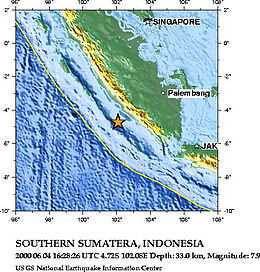2000 Sumatra earthquake
 | |
| Date | June 4, 2000 |
|---|---|
| Magnitude | 7.9 Mw |
| Depth | 33 kilometres (21 mi)[1] |
| Epicenter | 4°43′S 102°05′E / 4.72°S 102.08°E[1] |
| Areas affected | Indonesia |
| Casualties | 103 people dead, 2,174 injured[1] |
The 2000 Sumatra earthquake struck at 23:30 local time on June 4, 2000 off the coast of southern Sumatra, Indonesia with a magnitude of 7.9 Mw. The United States Geological Survey reported 103 fatalities, in addition to 2,174 injured people. Over 730 aftershocks shocked the area afterwards, one just eleven minutes after the main earthquake.
This was the first and southernmost in a series of very large to great Sumatran earthquakes in the 2000s to rupture almost the entire western part of the Sunda megathrust, most notably including the 9.1-9.3 2004 Indian Ocean Earthquake, but also the 8.6-8.7 2005 Sumatra earthquake, and the 7.9-8.5 September 2007 Sumatra earthquakes.
Background and tectonics
Indonesia is well known for strong earthquakes: the 2000 Sumatra event marked the beginning of an ongoing period of seismic activity in the area, highlighted by the 2004 Indian Ocean earthquake. The 2000 Sumatra earthquake took place at the southeastern end of the fault segment that ruptured during the 1833.[2] This group of earthquakes, in addition to the 2005 Sumatra earthquake, all ruptured along the megathrust that forms the interface between the Australian and Sunda Plates. This event was the only one of these earthquakes not to cause a tsunami.
Damage and casualties
The earthquake struck at 23:30 local time, its magnitude reaching a "major" 7.9. Aftershocks began striking as soon as 11 minutes after the earthquake, the first one surpassing magnitude 6.5. At least 103 people were killed by the earthquake, and 2,174 more were left injured. The Indonesian Red Cross later reported that 788 had been injured to concern, and 1,709 more were considered injured—the organization reported that the numbers were rapidly increasing.
Extensive damage and landslides populated the Bengkulu area, with minor injuries and damage on Enggano Island.[1] In the village worst struck, several hundred structures were reported in ruins.[3] Peter Walker of the International Federation of Red Cross and Red Crescent Societies in Geneva denied the earthquake as the major cause of death, instead blaming disease. "...the actual damage from the earthquake isn't that great; the houses are wooden structures so they don't collapse much. But what he found was an endemic problem of rampant malaria, rampant communicable diseases and levels of mortality and morbidity that are totally unacceptable. That is the disaster, not the earthquake."[4] An aftershock measuring 6.2 struck on June 7.[5]
Aftermath and response
International relief teams arrived in the region several days after the earthquake.[6] Relief efforts were impeded by fallen telephone poles, which blocked the supplies.[3] The main problem found in the affected areas was a lack of water supply and electricity, these facilities having been cut off by oscillation.[3] Pope John Paul II expressed his "sincere sympathy" for those families stricken by the earthquake.[7] He called for a rapid international response to the quake, and said he would keep its victims in his prayers.[7] A Taiwanese rescue team was sent to help victims of the tremor, the first from the country to take part in rescue efforts aside from Asia. The United States donated US$ 25,000 instantly to relief organizations, Japan offering a grant of US$ 140,000 and Australia US$ 143,000 in addition to a two-person team of emergency relief examiners.[8]
References
- ↑ 1.0 1.1 1.2 1.3 "Magnitude 7.9 SOUTHERN SUMATERA, INDONESIA". United States Geological Survey. 2004-03-30. Retrieved 2008-07-28.
- ↑ Sieh, K. "The Sunda megathrust: past, present and future" (PDF). Retrieved 2009-11-04.
- ↑ 3.0 3.1 3.2 "Indonesia appeals for help following Sumatran earthquake". RTÉ News. June 5, 2000.
- ↑ Tim Radford (July 6, 2000). "Just an everyday disaster". The Guardian. Retrieved June 4, 2009.
- ↑ "Photo Essay 6/8/2000 - Earthquake in Indonesia". Time Magazine. 2000-06-08. Retrieved 2008-07-29.
- ↑ UN relief report published 19 June 2000.
- ↑ 7.0 7.1 "Pope Comforts Indonesian Quake Victims". Catholic World News. 2000-06-06.
- ↑ Catherine Sung (June 8, 2000). "Rescue team on the way". Taipei Times. Retrieved June 4, 2009.
| ||||||